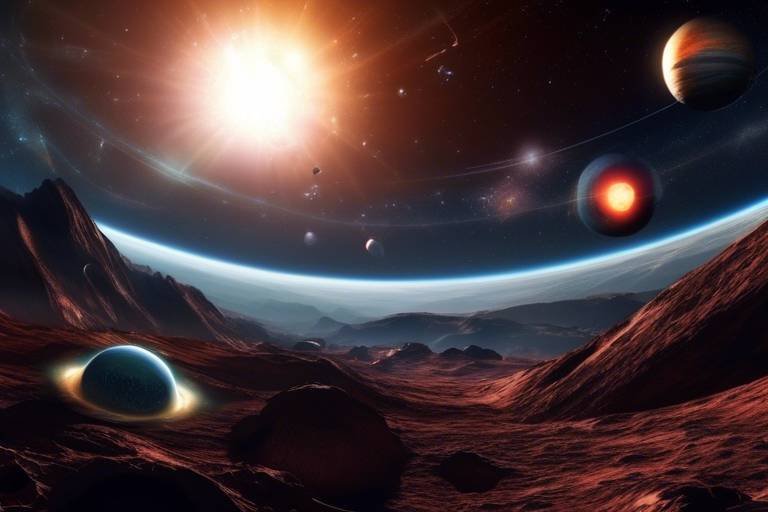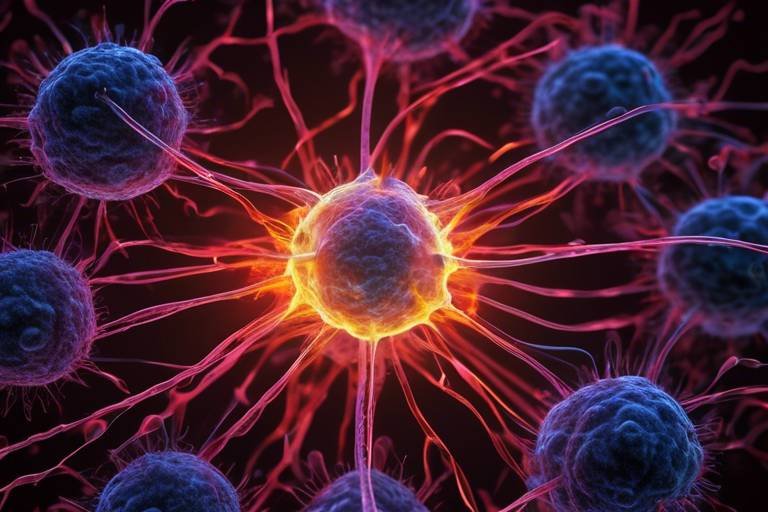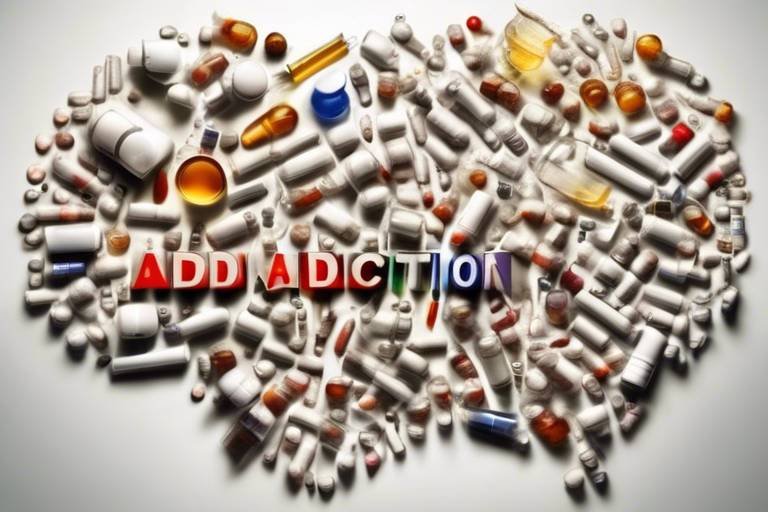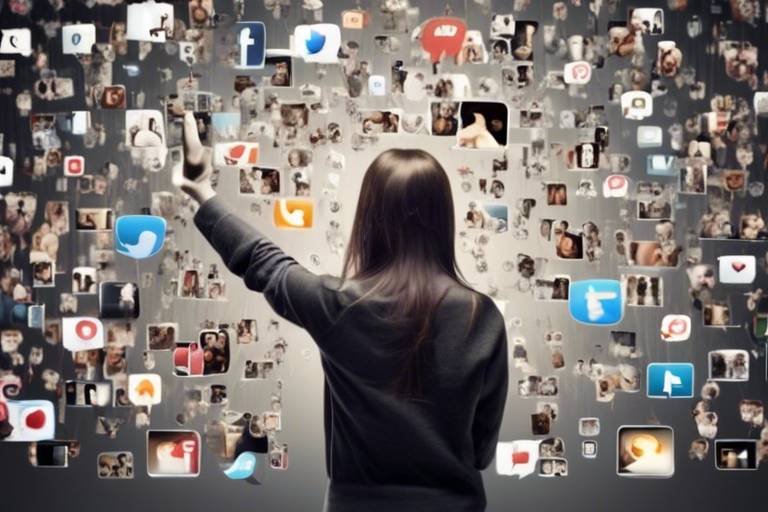The Impact of Social Media on Scientific Communication
In today's fast-paced digital world, the way we communicate has undergone a seismic shift, and social media stands at the forefront of this transformation. Gone are the days when scientific findings were locked away in dusty journals, only accessible to a select few. Now, with just a few clicks, researchers, practitioners, and the general public can share, discuss, and dissect scientific information in real time. This article delves into the multifaceted impact of social media on scientific communication, highlighting both the remarkable benefits and the challenges that come with this new era of information sharing.
Social media has revolutionized the speed and accessibility of scientific communication, allowing for real-time sharing of research findings and fostering greater collaboration among scientists across geographical boundaries. Imagine a world where a groundbreaking discovery in a lab in Tokyo can be shared instantly with a researcher in New York, sparking discussions and collaborations that transcend borders. This immediacy not only accelerates the pace of scientific discovery but also democratizes access to knowledge, making it available to anyone with an internet connection.
Platforms like Twitter and Facebook have made it easier for scientists to engage with the public, helping to demystify scientific concepts and promoting a greater understanding of scientific issues among non-experts. Through engaging posts, videos, and interactive content, scientists can break down complex ideas into digestible pieces, making science more relatable. This engagement is crucial, especially in an age where scientific literacy is more important than ever. When the public feels connected to scientific discourse, they are more likely to trust and support scientific endeavors.
However, while social media facilitates information dissemination, it also poses significant risks, particularly the spread of misinformation. In a landscape where anyone can post anything, the line between credible science and sensationalism can become blurred. This leads to public confusion and distrust in scientific research and findings. For example, during health crises like the COVID-19 pandemic, misinformation spread like wildfire, complicating public health responses and undermining trust in experts.
To combat misinformation, scientists and institutions are developing strategies, including fact-checking initiatives and promoting scientifically accurate content. By partnering with social media platforms, they aim to enhance public understanding and provide reliable information. For instance, some organizations are leveraging algorithms to prioritize credible sources in users' feeds, ensuring that accurate scientific information reaches the public more effectively.
Interestingly, influencers and popular science communicators play a significant role in shaping public perceptions of science. These individuals often bridge the gap between complex scientific concepts and everyday understanding. By using their platforms to share engaging content, they can make science accessible and appealing to a broader audience. This trend highlights the importance of effective science communication in a world where attention spans are short, and competition for engagement is fierce.
Moreover, social media platforms provide unique opportunities for scientists to network and collaborate, facilitating partnerships that may not have occurred through traditional channels. For example, researchers can join online forums or groups specific to their fields, allowing them to share insights, seek advice, and even find collaborators for future projects. This kind of networking can lead to innovative research ideas and multidisciplinary approaches that enrich the scientific community.
The traditional model of publishing research in journals is evolving, with social media acting as a powerful tool for disseminating findings to wider audiences, including policymakers and practitioners. No longer confined to the pages of academic journals, research can now gain visibility and traction on social media platforms, influencing real-world decisions and practices.
Additionally, social media supports the open science movement by encouraging researchers to share data and findings openly. This fosters transparency and collaboration within the scientific community, allowing others to build upon existing work. Open access to research not only accelerates the pace of discovery but also enhances the credibility of science as a whole.
As technology continues to evolve, social media's role in scientific communication is likely to expand. We can expect to see more interactive formats, such as live Q&A sessions, webinars, and virtual conferences, becoming commonplace. These innovations will further influence how research is conducted, shared, and perceived in society, making it essential for scientists to adapt and embrace these changes.
- What is the role of social media in scientific communication? Social media facilitates faster information sharing, enhances public engagement, and provides networking opportunities for scientists.
- How does misinformation affect scientific communication? Misinformation can lead to public confusion and distrust in scientific findings, complicating efforts to communicate accurate information.
- What strategies are being developed to combat misinformation? Strategies include fact-checking initiatives and promoting credible sources of information on social media platforms.
- How can scientists effectively use social media? Scientists can use social media to engage with the public, share their research, and collaborate with others in their field.

Changing Dynamics of Information Sharing
Social media has dramatically transformed the landscape of scientific communication. Gone are the days when researchers had to rely solely on traditional journals and conferences to share their findings. Now, with just a few clicks, scientists can disseminate their research to a global audience in real-time. This shift has not only increased the speed at which information travels but has also made it significantly more accessible to a wider range of audiences, including the general public, policymakers, and other researchers.
Imagine a world where groundbreaking discoveries are shared instantly, sparking conversations and collaborations across continents. This is the reality we live in today. Social media platforms like Twitter, Facebook, and LinkedIn have become vital tools for scientists, allowing them to connect with peers and engage with non-experts. For instance, a researcher in Australia can tweet about their latest findings, and within minutes, colleagues in Europe or North America can respond, share, or even build upon that work. This interconnectedness fosters a sense of community and encourages collaboration that was previously unimaginable.
Moreover, social media has democratized the process of information sharing. Researchers no longer need to navigate the often complex and costly publication processes to reach their audience. Instead, they can share preprints, data sets, and even informal updates directly on their social media profiles. This not only speeds up the dissemination of knowledge but also allows for immediate feedback from the community. The traditional barriers to entry are being dismantled, paving the way for a more inclusive scientific dialogue.
However, with this new dynamic comes a responsibility. Researchers must be mindful of the information they share and the potential impact it may have. As they engage in discussions online, they must ensure that their contributions are accurate and well-founded. This is particularly crucial in an era where misinformation can spread just as quickly as legitimate research. Therefore, while social media platforms enhance communication, they also necessitate a higher level of scrutiny and critical thinking among scientists and the public alike.
In summary, the changing dynamics of information sharing brought about by social media have transformed scientific communication into a more interactive and collaborative process. As researchers embrace these platforms, they unlock new opportunities for engagement and innovation that can ultimately lead to a more informed and scientifically literate society.

Enhancing Public Engagement with Science
Social media has become a game changer in the realm of science communication. Gone are the days when scientific findings were locked away in dusty journals, only accessible to a select few. Now, platforms like Twitter, Facebook, and Instagram allow scientists to connect directly with the public, breaking down barriers and fostering a more inclusive dialogue about scientific issues. This direct line of communication not only makes science more approachable but also helps to demystify complex concepts that might otherwise intimidate non-experts.
Imagine scrolling through your social media feed and coming across a scientist explaining the latest breakthrough in climate change research in a short video clip. This is the beauty of social media—it allows for dynamic storytelling. Scientists can share their research in engaging formats, such as infographics, live Q&A sessions, and interactive polls, making the information not just informative but also entertaining. This type of engagement can spark curiosity and encourage the public to ask questions, leading to a deeper understanding of the subject matter.
Moreover, social media platforms serve as a two-way street for communication. It's not just about scientists broadcasting their findings; it's also about listening to the public's concerns and questions. For instance, during the COVID-19 pandemic, many researchers took to social media to clarify misinformation, answer questions, and provide updates on vaccine development. This real-time interaction helped to build trust and transparency, which are vital in maintaining public confidence in scientific endeavors.
However, the challenge remains: how do we ensure that the information shared via social media is both accurate and accessible? To tackle this, scientists and institutions are increasingly collaborating with science communicators and influencers who specialize in making complex topics digestible. These individuals often have a knack for breaking down intricate ideas into bite-sized pieces that resonate with a broader audience. By leveraging their platforms, they can amplify important messages and ensure that scientific information reaches those who need it most.
In essence, social media is not just a tool for dissemination; it's a platform for engagement and education. As more scientists embrace these platforms, the potential for enhancing public understanding of science grows exponentially. The key is to continue fostering this dialogue, encouraging curiosity, and promoting a culture where science is seen as a vital part of our everyday lives. So, the next time you see a scientist on your feed, take a moment to engage. Ask questions, share your thoughts, and become part of the conversation!
- How can I follow scientists on social media? Look for hashtags related to your interests, or follow popular science organizations and institutions that share research updates.
- What types of content do scientists share on social media? Scientists share a variety of content, including research updates, educational videos, infographics, and interactive discussions.
- Can I ask questions to scientists on social media? Absolutely! Many scientists encourage questions and discussions, so don’t hesitate to engage with them.

Challenges of Misinformation
In the age of social media, the **challenges of misinformation** have become a pressing concern for scientists and the general public alike. While these platforms offer incredible opportunities for sharing knowledge, they also serve as fertile ground for the spread of inaccurate information. Imagine a game of telephone, where the original message is transformed into something entirely different by the time it reaches the last person. This is often what happens with scientific information on social media.
The rapid pace at which information circulates can lead to misunderstandings and misinterpretations. For instance, a groundbreaking study may be summarized in a tweet, but the nuance and complexity of the research can easily be lost in translation. As a result, the public may form opinions based on incomplete or misleading information. This phenomenon is particularly concerning in fields like medicine, where misinformation can have serious health implications.
Some of the most common challenges associated with misinformation include:
- Rapid Spread: Information can go viral in a matter of hours, making it difficult to correct inaccuracies before they become entrenched in public discourse.
- Lack of Context: Posts often lack the necessary context to understand the research fully, leading to misinterpretations.
- Echo Chambers: Social media algorithms can create echo chambers, where users are only exposed to information that reinforces their existing beliefs.
These challenges create a landscape where public trust in scientific research can be easily eroded. When misinformation spreads unchecked, it leads to skepticism towards scientific institutions and findings. This skepticism is further exacerbated by the fact that many people may not have the background knowledge to critically evaluate the information they encounter online. As a result, they may inadvertently share or believe false information, perpetuating the cycle of misinformation.
Moreover, the emotional appeal of sensationalized headlines often overshadows the more nuanced and factual reporting of scientific findings. This can lead to a public that is more inclined to believe dramatic claims over balanced, evidence-based conclusions. For instance, a headline claiming "New Study Shows X Can Cure Y!" is likely to attract more attention than a detailed analysis of the study's methodology and limitations.
In conclusion, while social media has the potential to enhance scientific communication, it also poses significant challenges in the form of misinformation. Addressing these challenges requires a concerted effort from scientists, institutions, and social media platforms to promote accurate information and improve public understanding of scientific concepts.
- What is misinformation in the context of social media?
Misinformation refers to false or misleading information that is spread, regardless of intent. On social media, this can occur through misinterpretations of scientific studies or sensationalized headlines. - How can I identify credible scientific information on social media?
Look for information shared by reputable sources, such as academic institutions or peer-reviewed journals. Check for citations and references to original studies. - What role do scientists play in combating misinformation?
Scientists can engage with the public, clarify misunderstandings, and provide accurate information through various platforms to help counter misinformation.

Addressing the Misinformation Challenge
In today's digital age, the challenge of misinformation looms large, particularly in the realm of scientific communication. With the rapid spread of information through social media, it can be all too easy for false claims and misleading data to gain traction. This situation is akin to a game of telephone, where the original message becomes distorted as it passes from person to person. To combat this phenomenon, scientists and institutions are stepping up to the plate with innovative strategies aimed at fostering a more informed public.
One effective approach is the establishment of fact-checking initiatives. These initiatives are designed to scrutinize the accuracy of information circulating on social media platforms, ensuring that only scientifically sound data reaches the public. By collaborating with fact-checking organizations, researchers can create a robust defense against misinformation, much like building a fortress to protect valuable knowledge.
Moreover, promoting scientifically accurate content is crucial. Scientists are increasingly utilizing social media to share their research findings in a way that is both engaging and understandable. This not only helps in disseminating correct information but also encourages a culture of curiosity and inquiry among the general public. Imagine a world where complex scientific concepts are simplified and made relatable—this is the goal of many scientists today.
Additionally, educational campaigns aimed at enhancing media literacy among the public are gaining traction. These campaigns focus on teaching individuals how to critically evaluate sources of information, fostering a more discerning audience that can navigate the vast sea of content available online. By equipping people with the tools to identify credible sources, we empower them to distinguish between fact and fiction.
Furthermore, scientists are leveraging the power of social media influencers. Influencers who are passionate about science can help bridge the gap between researchers and the public, translating intricate scientific ideas into digestible content. This relationship can be mutually beneficial, as influencers gain credibility from associating with authoritative voices in science, while researchers reach a broader audience.
In summary, addressing the misinformation challenge requires a multifaceted approach that combines fact-checking, the promotion of accurate content, media literacy education, and collaboration with influencers. By employing these strategies, the scientific community can work towards creating a more informed society, where the public can confidently engage with scientific information.
- What is misinformation in the context of scientific communication? Misinformation refers to false or misleading information that is spread regardless of intent. In science, this can lead to public confusion and mistrust.
- How can social media help combat misinformation? Social media can be used to disseminate accurate information quickly and engage the public in discussions about science, while fact-checking initiatives can clarify any misconceptions.
- What role do influencers play in science communication? Influencers can help make complex scientific concepts more relatable to the general public, bridging the gap between researchers and non-experts.
- Why is media literacy important? Media literacy empowers individuals to critically evaluate information sources, helping them discern credible scientific information from misinformation.

Role of Influencers in Science Communication
In today's digital age, the role of influencers in science communication cannot be overstated. These individuals, often equipped with a substantial following on platforms like Instagram, Twitter, and YouTube, have the unique ability to bridge the gap between complex scientific concepts and the general public. Imagine a scientist explaining quantum physics in a language that even your grandma would understand—this is the magic that influencers can create. They have the power to transform dry, academic jargon into engaging stories that resonate with everyday people.
One of the most compelling aspects of influencers is their knack for storytelling. By weaving narratives around scientific discoveries, they make the information not only accessible but also relatable. For instance, consider a popular science communicator who uses humor and personal anecdotes to explain climate change. This approach not only captivates the audience but also encourages them to share the information within their own social circles, thereby amplifying the message.
Furthermore, influencers often engage their audiences through interactive content, such as live Q&A sessions or polls, which foster a sense of community. This interaction demystifies science and invites people to ask questions they might feel shy about in a traditional academic setting. It’s akin to having a coffee chat with a scientist instead of sitting through a formal lecture—much more inviting, right?
However, it’s essential to recognize that not all influencers are created equal. The credibility of the information shared can vary widely. This is where the responsibility of influencers comes into play. They must ensure that the content they share is not only engaging but also scientifically accurate. To help maintain this integrity, many influencers collaborate with scientists, institutions, and organizations to verify their content before sharing it with their followers.
In addition to enhancing public understanding, influencers also serve as a vital link between scientists and the media. They can help amplify research findings, making them more palatable for journalists and, in turn, the broader public. By doing so, they contribute to a more informed society, where scientific literacy is not just a goal but a reality.
To sum up, influencers are reshaping the landscape of science communication. They bring a fresh perspective, making science more relatable and engaging for the masses. As we continue to navigate this digital era, their role will likely become even more pronounced, driving public interest in scientific issues and fostering a culture of inquiry and understanding.
- What is the role of influencers in science communication? Influencers help make complex scientific concepts accessible and relatable to the general public through engaging storytelling and interactive content.
- How do influencers ensure the accuracy of the information they share? Many influencers collaborate with scientists and institutions to verify their content before sharing it with their audiences.
- Can influencers impact public understanding of science? Yes, by bridging the gap between scientists and the public, influencers can significantly enhance public understanding and interest in scientific issues.

Collaboration and Networking Opportunities
Social media platforms have emerged as vibrant hubs for scientific collaboration and networking, breaking down the barriers that once restricted communication among researchers. Imagine a bustling marketplace where scientists from different fields and regions come together, exchanging ideas and forming partnerships that can lead to groundbreaking discoveries. This transformation is not just a trend; it’s a fundamental shift in how science is conducted and shared.
With platforms like Twitter, LinkedIn, and ResearchGate, the possibilities for collaboration are virtually limitless. Researchers can connect with peers who share similar interests or complementary expertise, creating opportunities for interdisciplinary projects that might not have been possible in the past. For instance, a biologist studying climate change can easily find a physicist working on renewable energy, leading to innovative solutions that address environmental challenges.
Moreover, social media enables scientists to participate in global conversations. Conferences and workshops are no longer confined to physical locations; they can be streamed live, and discussions can continue online long after the event has ended. This accessibility allows for a broader range of voices to be heard, enriching the scientific discourse. Imagine being able to follow a conference hashtag and engage with leading experts from around the world, all from the comfort of your home. It's like having a front-row seat to a world-class event!
Additionally, many researchers are leveraging social media to showcase their work. By sharing their findings, they not only increase their visibility but also invite feedback and collaboration from others in the field. This practice fosters a sense of community among scientists, making it easier to reach out for assistance or advice. As a result, researchers are more likely to collaborate on projects, share resources, and support each other’s work.
However, it’s important to approach these networking opportunities with a strategic mindset. Researchers should consider the following tips to maximize their engagement on social media:
- Be Active: Regularly share insights, articles, and updates about your research to keep your audience engaged.
- Engage with Others: Comment on posts, ask questions, and participate in discussions to build relationships.
- Use Hashtags: Utilize relevant hashtags to increase the visibility of your posts and connect with broader audiences.
- Join Groups: Participate in online groups or forums related to your field to find potential collaborators.
In conclusion, the advent of social media has fundamentally altered the landscape of scientific collaboration and networking. By embracing these platforms, researchers can forge connections that not only enhance their own work but also contribute to the advancement of science as a whole. The future of scientific inquiry is not just about individual brilliance; it’s about the collective power of collaboration, and social media is the key to unlocking that potential.
- How can I effectively use social media for scientific collaboration? Start by engaging with others in your field, sharing your research, and participating in discussions relevant to your work.
- What are the best platforms for scientists to network? Twitter, LinkedIn, and ResearchGate are popular choices for researchers to connect and collaborate.
- Can social media help in finding research funding? Yes, many funding opportunities are shared on social media, and networking can lead to potential partnerships that attract funding.
- How do I avoid misinformation while using social media? Always verify information through reputable sources and engage with trusted experts in your field.

Impact on Research Dissemination
In today's digital age, the way research is disseminated has undergone a radical transformation. Traditionally, researchers would publish their findings in academic journals, often behind paywalls that limited access to only those affiliated with educational institutions or who could afford subscriptions. However, with the advent of social media, this model is rapidly evolving. Now, researchers can share their findings directly with the public and other scientists through platforms like Twitter, Facebook, and LinkedIn. This shift not only increases the visibility of their work but also democratizes access to scientific knowledge. Imagine being able to read the latest breakthrough in cancer research while scrolling through your Twitter feed—this is the new reality of scientific communication!
Social media acts as a powerful catalyst for disseminating research findings to a broader audience, including policymakers, practitioners, and the general public. This immediate access to information can lead to faster implementation of scientific discoveries in real-world applications. For instance, during health crises like the COVID-19 pandemic, scientists utilized social media to share vital information and updates, which proved crucial in shaping public health responses. The speed at which information travels today is unprecedented, allowing for a rapid exchange of ideas and findings that can lead to collaborative efforts across disciplines.
Furthermore, social media enables researchers to interact with their audience in real-time. They can answer questions, clarify doubts, and engage in discussions that were previously limited to academic conferences or peer-reviewed publications. This level of interaction fosters a sense of community and collaboration among scientists and non-scientists alike. However, with this increased accessibility comes the responsibility to ensure that the information shared is accurate and credible. Researchers must be vigilant in how they present their findings, as the potential for misinformation is ever-present in the fast-paced world of social media.
To illustrate the impact of social media on research dissemination, consider the following table that highlights the differences between traditional and modern methods of sharing scientific research:
| Aspect | Traditional Dissemination | Modern Dissemination via Social Media |
|---|---|---|
| Accessibility | Limited to journal subscribers | Open to anyone with internet access |
| Speed | Months to years for publication | Real-time sharing of findings |
| Interactivity | One-way communication | Two-way engagement with audiences |
| Audience | Primarily academic and institutional | Broader public, including policymakers |
As we can see, the shift towards social media has significantly altered the landscape of research dissemination. Researchers now have the ability to reach a diverse audience, fostering greater public engagement with science. However, this new paradigm also requires a commitment to uphold the integrity of scientific communication. As social media continues to evolve, it will be fascinating to observe how these platforms shape the future of research dissemination and influence the way scientific knowledge is shared and understood.
- How has social media changed scientific communication? Social media has made scientific communication faster, more accessible, and interactive, allowing researchers to engage directly with the public and share findings in real-time.
- What are the risks associated with sharing research on social media? The primary risk is the potential for misinformation to spread, which can lead to public confusion and distrust in scientific findings.
- How can researchers ensure their information is credible on social media? Researchers should verify their sources, engage in fact-checking, and promote scientifically accurate content to enhance public understanding.

Open Science Movement
The is an exciting and transformative approach that is reshaping the landscape of scientific research and communication. Imagine a world where scientific findings are not locked away behind paywalls, but are freely accessible to anyone with an internet connection. This is the essence of open science: transparency, accessibility, and collaboration. By embracing this movement, researchers are not just sharing their findings; they're inviting others to join in the conversation, to critique, to build upon, and to innovate.
One of the most significant benefits of the Open Science Movement is that it democratizes knowledge. In traditional models, access to scientific papers often requires costly subscriptions or institutional affiliations, creating barriers for independent researchers, students, and the general public. However, with the rise of social media and open-access repositories, scientists can now share their work widely. For instance, platforms like arXiv and bioRxiv allow researchers to upload their preprints, making them available for free before formal peer review.
Moreover, the Open Science Movement encourages collaboration across disciplines and borders. Scientists can connect with peers worldwide through social media platforms, fostering an environment where ideas can flow freely. This interconnectedness can lead to groundbreaking discoveries, as diverse perspectives often yield innovative solutions to complex problems. For example, a biologist in one country can collaborate with a data scientist in another, leveraging their unique expertise to tackle pressing global challenges like climate change or pandemic responses.
However, the movement is not without its challenges. While open science promotes transparency, it also raises questions about the quality and integrity of research. As more researchers share their findings openly, the risk of misinformation can increase. To counter this, the scientific community is establishing rigorous standards for sharing data and findings. This includes practices like data sharing, where researchers make their raw data available for others to analyze, and open peer review, where the review process is transparent and accessible to the public.
In summary, the Open Science Movement is a powerful force that is redefining how science is conducted and communicated. By prioritizing openness and collaboration, it not only enhances the quality of research but also engages the public in meaningful ways. As we continue to navigate the complexities of the modern world, the principles of open science will undoubtedly play a crucial role in shaping the future of scientific inquiry and understanding.
- What is the Open Science Movement?
The Open Science Movement advocates for making scientific research and data accessible to everyone, promoting transparency and collaboration within the scientific community.
- How does open science benefit researchers?
Open science allows researchers to share their findings widely, collaborate with others, and gain visibility for their work, ultimately enhancing their impact.
- What are the challenges associated with open science?
Challenges include ensuring the quality and integrity of shared research, combating misinformation, and establishing standards for open data practices.
- How can I access open science resources?
Many open-access journals and preprint servers, like arXiv and bioRxiv, provide free access to research papers. Additionally, social media platforms often share valuable scientific insights.

Future Trends in Scientific Communication
The landscape of scientific communication is continuously evolving, and as we look towards the future, several trends are emerging that promise to reshape how science is shared and understood. One of the most significant trends is the increasing integration of artificial intelligence (AI) and machine learning tools in the research process. These technologies are not only streamlining data analysis but also enhancing the way findings are communicated. Imagine AI systems that can summarize complex research papers into digestible formats for the public or even generate engaging content that highlights key findings. This could lead to a more informed public, capable of engaging with scientific discussions.
Another exciting trend is the rise of multimedia content. Traditional text-based articles are being supplemented with videos, podcasts, and interactive graphics. This shift is not just about making science more appealing; it's about making it more accessible. For instance, a short video explaining a complicated concept can resonate with audiences far better than a lengthy article. As platforms like YouTube and TikTok gain popularity, scientists are finding innovative ways to present their work through these channels, reaching younger and more diverse audiences.
Moreover, the concept of collaborative science is gaining traction. Social media is already facilitating partnerships between researchers from different disciplines and geographical locations. In the future, we can expect even more collaborative platforms that allow scientists to work together in real-time, sharing data and insights seamlessly. This could lead to faster advancements in research and a more cohesive scientific community. Imagine a world where a team of scientists from various fields can come together on a single platform to tackle global challenges like climate change or pandemics.
Additionally, the increasing emphasis on open access publishing is set to transform how research is disseminated. As funding agencies and institutions push for transparency and accessibility, more researchers are likely to share their findings freely on social media and open-access journals. This democratization of knowledge ensures that everyone, regardless of their background, has access to the latest scientific advancements. It also encourages a culture of sharing and collaboration, breaking down the barriers that have traditionally existed in academic publishing.
Lastly, the role of science communicators and influencers will continue to grow. These individuals are crucial in translating complex scientific ideas into relatable content for the general public. As more people turn to social media for information, the demand for credible voices in science communication will increase. This trend not only helps in bridging the gap between scientists and the public but also fosters a culture of curiosity and learning.
In summary, the future of scientific communication is bright, characterized by technological advancements, multimedia engagement, collaborative efforts, open access, and the vital role of science communicators. As we embrace these changes, we can look forward to a more informed society where scientific literacy is the norm, not the exception.
- How is social media changing scientific communication? Social media allows for real-time sharing of research findings, enhancing collaboration and engagement between scientists and the public.
- What are the risks associated with misinformation on social media? Misinformation can lead to public confusion and distrust in scientific research, making it essential for scientists to promote accurate content.
- What role do influencers play in science communication? Influencers help bridge the gap between complex scientific concepts and public understanding, making science more relatable.
- How does open access publishing impact research dissemination? Open access ensures that research is freely available to everyone, fostering transparency and collaboration within the scientific community.
Frequently Asked Questions
- How has social media changed scientific communication?
Social media has drastically altered the landscape of scientific communication by enabling researchers to share findings instantly and engage with a broader audience. This real-time interaction fosters collaboration across borders and allows for quicker dissemination of information.
- What are the benefits of using social media for public engagement in science?
Platforms like Twitter and Facebook help scientists connect with the public, making complex scientific ideas more accessible. This engagement demystifies science, encourages dialogue, and promotes a better understanding of scientific issues among everyday people.
- What risks does social media pose regarding misinformation?
While social media accelerates information sharing, it also increases the risk of spreading misinformation. This can lead to public confusion and erode trust in scientific research, making it crucial for scientists to address these challenges effectively.
- How are scientists combating misinformation on social media?
Scientists and institutions are implementing various strategies to tackle misinformation, such as fact-checking initiatives and promoting scientifically accurate content. These efforts aim to enhance public understanding and reinforce trust in scientific findings.
- What role do influencers play in science communication?
Influencers and popular science communicators serve as bridges between complex scientific concepts and the general public. They help shape perceptions of science and make it more relatable, often driving interest and engagement in scientific topics.
- How does social media facilitate collaboration among scientists?
Social media platforms provide unique networking opportunities for scientists, allowing them to connect and collaborate in ways that traditional methods may not support. This can lead to innovative partnerships and collaborative research projects.
- What impact does social media have on research dissemination?
Social media is transforming the traditional model of research dissemination by allowing findings to reach wider audiences, including policymakers and practitioners. This broader reach can influence decision-making and encourage the application of research in real-world scenarios.
- How does social media support the open science movement?
Social media encourages researchers to share their data and findings openly, promoting transparency and collaboration within the scientific community. This openness fosters a culture of sharing knowledge and resources, benefiting the entire field.
- What future trends can we expect in scientific communication through social media?
As technology continues to evolve, the role of social media in scientific communication is expected to expand. This may lead to new methods of research sharing, enhanced public engagement, and innovative ways of conducting and perceiving scientific work.



















